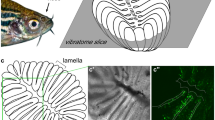Abstract
The mechanisms of electromechanical and electrochemical coupling in olfactory cilia of the frog (Rana temporaria) have been investigated. High-resolution optical television microscopy of live tissue and pharmacological analysis have been used to reveal the regulation of the motility of olfactory cilia in the absence of odorants; the entry of Ca2+ ions mediated by three types of ion channels (mechanosensitive, cyclic nucleotide gated, and voltage-gated) was shown to determine the motility of cilia. Stimulation of the olfactory adenylate cyclase by movements of the cilia in the absence of odors has been demonstrated and the regulation of cilia motility by membrane potential has been revealed. Membrane potential can affect olfactory acuity and the ability to perceive weak olfactory stimuli in the absence of adequate stimulation.
Similar content being viewed by others
Abbreviations
- OC:
-
olfactory cilia
- СNG channels:
-
cyclic nucleotide-gated ion channels
References
C. Zelano and N. Sobel, Neuron 48 (3), 431 (2005).
S. J. Kleene, Chem. Senses 33, 839 (2008).
B. Lindemann, Biophys. J. 80, 1712 (2001).
R. Y. K. Pun and S. J. Kleene, Biophys. J. 84, 3425 (2003).
R. Y. K. Pun and S. J. Kleene, J. Physiol. 559 (2), 535 (2004).
T. Miyamoto, D. Restrepo, and J. H. Teeter, J. Gen. Physiol. 99, 505 (1992).
R. Delgado, M. V. Saavedra, O. Schmachtenberg, et al., J. Neurophysiol. 90, 2022 (2003).
S. Frings, S. Benz, and B. Lindemann, J. Gen. Phsyiol. 97 (4), 725 (1991).
J. S. Kleene, R. C. Gestel, S. H. Bryant, J. Exp. Biol. 195, 307 (1994).
A. Tomaru and T. Kurahashi, J. Neurophysiol. 93, 1880 (2005).
P. Duchamp-Viret, A. Duchamp, and M. A. Chaput, J. Neurosci. 20, 2383 (2000).
A. A. Bronshtein, Olfacory Receptors of Vertebrates (Nauka, Leningrad, 1977) [in Russian].
E. V. Bigdai and V. O. Samoilov, Tsitologiya 54 (9), 666 (2012).
R. C. Challis, H. Tian, W. Yin, et al., PLOS ONE 11 (3), e0150638 (2016). doi doi 10.1371/journal. pone.0150638
P. A. Watson, J. Biol. Chem. 265 (12), 6569 (1990).
A. E. Dubin and V. E. Dionne, J. Gen. Physiol. 103 (2),181(1994).
USSR Ministry of Health, Order No. 755 of August 12, 1977.
J. Reisert, P. J. Bauer, K.-W. Yau, et al., J. Gen. Physiol. 122, 349 (2003).
D. A. Evstigneev, Extended Abstract of Candidate’s Dissertation in Biology (Uluanovsk, 2003).
S. Takahashi, M. Shibata, Y. Fukuuchi, Brain Res. Dev. Brain Res. 104 (1–2), 111 (1997).
K. Meier, W. Knepel, and C. Schfl, Endocrinology 122 (6), 2764 (1988).
K. Hasegawa, Y. Tsukahara, M. Shimamoto, et al., J. Comp. Physiol. A 181, 41 (1997).
A. Darszon, P. Labarka, T. Nishigaki, et al., Physiol. Rev. 79 (2), 481 (1999).
K. Inaba, Cilia 4, 6 (2015).
M. Salathe and R. J. Bookman, J. Cell Sci. 108, 431 (1995).
V. T. Piascik, M. Babich, K. L. Jacobson, et al., Am. J. Physiol. 250 (4), 642 (1986).
J. Derher, M. Delling, and D. E. Clapham, eLife 4, e11066 (2015).
E. E. Davis, M. Brueckner, and N. Katsanis, Dev. Cell 11, 9 (2006).
D. M. F. Cooper, M. J. Schell, P. Thorn, et al., J. Biol. Chem. 273 (42), 27703 (1998).
Author information
Authors and Affiliations
Corresponding author
Additional information
Original Russian Text © E.V. Bigdaj, D.K. Fufachev, P.R. Petrov, V.O. Samojlov, 2017, published in Biofizika, 2017, Vol. 62, No. 2, pp. 311–318.
Rights and permissions
About this article
Cite this article
Bigdaj, E.V., Fufachev, D.K., Petrov, P.R. et al. Mechanisms of electromechanical and electrochemical coupling in olfactory cilia of the frog (Rana temporaria). BIOPHYSICS 62, 240–246 (2017). https://doi.org/10.1134/S0006350917020051
Received:
Accepted:
Published:
Issue Date:
DOI: https://doi.org/10.1134/S0006350917020051




